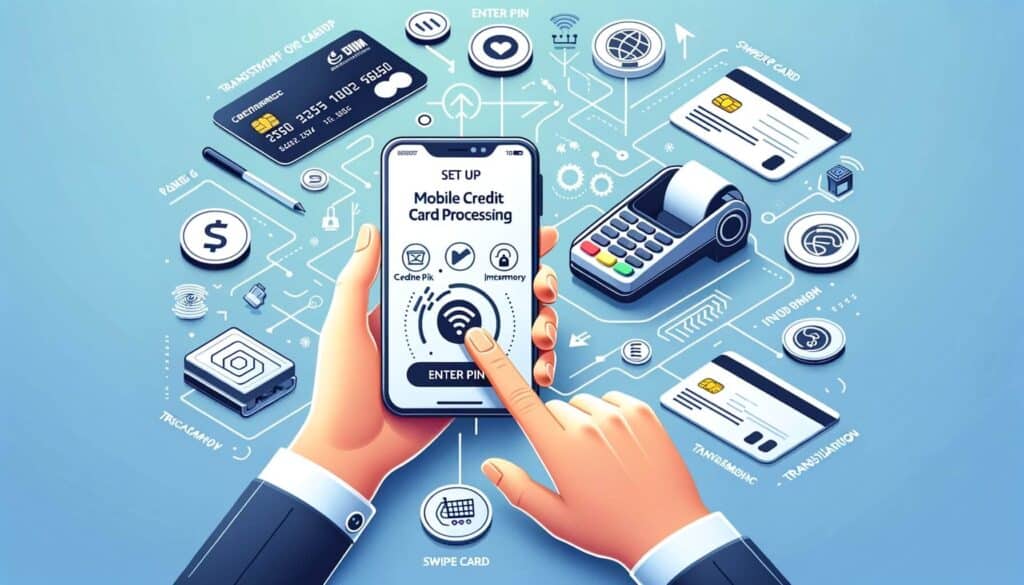
By Mollie Mills April 1, 2025
In today’s fast-paced and digital world, mobile credit card processing has become an essential tool for businesses of all sizes. With the rise of smartphones and tablets, customers now expect the convenience of being able to make purchases using their credit or debit cards wherever they go. This article will provide a comprehensive guide to mobile credit card processing, explaining what business owners need to know to make informed decisions about implementing this technology.
Benefits of Mobile Credit Card Processing for Business Owners

Mobile credit card processing offers numerous benefits for business owners. Firstly, it allows businesses to accept payments on the go, whether they are at a trade show, a pop-up shop, or even making deliveries. This flexibility can significantly increase sales opportunities and customer satisfaction.
Secondly, mobile credit card processing eliminates the need for traditional point-of-sale systems, which can be expensive and cumbersome. By using a mobile device and a card reader, businesses can save money on equipment costs and reduce the amount of physical space required to process payments.
Additionally, mobile credit card processing can improve cash flow by enabling businesses to receive payments instantly. With traditional payment methods, such as checks, there is often a delay in receiving funds. However, with mobile credit card processing, funds are typically deposited into the business’s account within one to two business days.
Furthermore, mobile credit card processing can enhance the overall customer experience. By offering the convenience of accepting credit cards or debit cards, businesses can attract more customers and provide a seamless checkout process. This can lead to increased customer loyalty and repeat business.
How Mobile Credit Card Processing Works

Mobile credit card processing works by utilizing a combination of hardware and software to securely transmit payment information from a customer’s credit or debit card to the business’s bank account. The process typically involves the following steps:
1. Mobile Device and Card Reader: To begin, a business owner needs a mobile device, such as a smartphone or tablet, and a compatible card reader. The card reader is connected to the mobile device via a headphone jack or Bluetooth.
2. Payment App: The business owner must download a payment app onto their mobile device. This app acts as the interface between the card reader and the payment processor.
3. Card Swipe or Manual Entry: When a customer is ready to make a purchase, their credit or debit card is either swiped through the card reader or the card information is manually entered into the payment app.
4. Encryption and Transmission: Once the card information is captured, it is encrypted to ensure the security of the transaction. The encrypted data is then transmitted to the payment processor through a secure internet connection.
5. Authorization and Approval: The payment processor sends the encrypted data to the customer’s bank for authorization. The bank verifies the card details and checks if the customer has sufficient funds to complete the transaction. If approved, the bank sends an authorization code back to the payment processor.
6. Confirmation and Receipt: The payment processor receives the authorization code and sends a confirmation message to the business owner’s mobile device. The business owner can then provide the customer with a receipt, either electronically or in print.
Choosing the Right Mobile Credit Card Processing Solution for Your Business

When selecting a mobile credit card processing solution for your business, there are several factors to consider. Here are some key considerations to help you make an informed decision:
1. Compatibility: Ensure that the mobile credit card processing solution is compatible with your mobile device and operating system. Some solutions may only work with specific devices or require certain software versions.
2. Card Reader Options: Evaluate the different card reader options available. Some card readers connect to the mobile device via a headphone jack, while others use Bluetooth. Consider the ease of use, durability, and security features of the card reader.
3. Payment App Features: Look for a payment app that offers the features you need for your business. This may include inventory management, customer data collection, and integration with other business systems.
4. Pricing Structure: Compare the pricing structures of different mobile credit card processing solutions. Consider factors such as transaction fees, monthly fees, and any additional costs for hardware or software.
5. Security Measures: Ensure that the mobile credit card processing solution has robust security measures in place to protect sensitive customer data. Look for features such as encryption, tokenization, and fraud detection.
Setting Up Mobile Credit Card Processing: Step-by-Step Guide

Setting up mobile credit card processing for your business involves several steps. Follow this step-by-step guide to get started:
1. Research and Compare Providers: Begin by researching different mobile credit card processing providers. Compare their features, pricing, and customer reviews to find the best fit for your business.
2. Choose a Provider and Sign Up: Once you have selected a provider, sign up for an account. This typically involves providing your business information, such as your legal name, address, and tax identification number.
3. Order Card Reader: If necessary, order a card reader from the provider. Ensure that it is compatible with your mobile device and operating system.
4. Download Payment App: Download the provider’s payment app onto your mobile device. Follow the instructions provided to install and set up the app.
5. Connect Card Reader: Connect the card reader to your mobile device according to the manufacturer’s instructions. This may involve plugging it into the headphone jack or pairing it via Bluetooth.
6. Test Card Reader: Test the card reader to ensure that it is functioning correctly. Swipe a test card or enter dummy card information to verify that the payment app is capturing the data accurately.
7. Configure Settings: Configure the settings in the payment app to meet your business’s needs. This may include setting tax rates, creating product listings, and customizing receipt templates.
8. Set Up Bank Account: Link your business bank account to the mobile credit card processing provider. This will allow funds from customer transactions to be deposited directly into your account.
9. Train Staff: If you have employees who will be using the mobile credit card processing system, provide them with training on how to use the payment app and card reader correctly.
10. Start Accepting Payments: Once everything is set up and tested, you are ready to start accepting payments. Promote your new mobile credit card processing capabilities to customers and enjoy the benefits of increased sales and customer satisfaction.
Understanding Mobile Credit Card Processing Fees and Costs
Mobile credit card processing fees and costs can vary depending on the provider and the specific pricing structure. Here are some common fees and costs to be aware of:
1. Transaction Fees: Most mobile credit card processing providers charge a fee for each transaction processed. This fee is typically a percentage of the transaction amount, ranging from 1% to 3%, plus a small fixed fee per transaction.
2. Monthly Fees: Some providers may charge a monthly fee for access to their mobile credit card processing services. This fee can range from $10 to $50 per month, depending on the provider and the features included.
3. Hardware Costs: If you need to purchase a card reader or other hardware, there may be an upfront cost involved. Card readers can range in price from $20 to $100, depending on the features and brand.
4. Chargeback Fees: In the event of a customer dispute or chargeback, some providers may charge a fee to cover the administrative costs of handling the dispute. This fee is typically around $15 to $25 per chargeback.
5. Additional Services: Some providers offer additional services, such as advanced reporting, inventory management, or customer loyalty programs, for an additional fee. Consider whether these services are necessary for your business and factor in the cost.
6. International Transaction Fees: If you plan to accept payments from customers outside of your home country, be aware that there may be additional fees for international transactions. These fees can vary depending on the provider and the specific transaction.
It is essential to carefully review the fee structure of each mobile credit card processing provider and consider how it aligns with your business’s needs and budget. Compare multiple providers to ensure you are getting the best value for your money.
Ensuring Security and Fraud Prevention in Mobile Credit Card Processing
Security and fraud prevention are critical considerations when implementing mobile credit card processing for your business. Here are some measures you can take to ensure the security of customer data and protect against fraud:
1. Encryption: Ensure that the mobile credit card processing solution you choose utilizes encryption to protect sensitive customer data. Encryption scrambles the data during transmission, making it unreadable to unauthorized parties.
2. Tokenization: Tokenization is a process that replaces sensitive card data with a unique identifier, known as a token. This token is used for transaction processing, while the actual card data is securely stored by the payment processor. Tokenization adds an extra layer of security by reducing the risk of cardholder data being compromised.
3. PCI Compliance: The Payment Card Industry Data Security Standard (PCI DSS) sets guidelines for securely handling credit card information. Ensure that your mobile credit card processing solution is PCI compliant and follows the necessary security protocols.
4. Fraud Detection: Look for a mobile credit card processing solution that includes fraud detection features. These features can help identify suspicious transactions and prevent fraudulent activity.
5. Employee Training: Train your employees on best practices for handling customer card information and detecting potential fraud. Emphasize the importance of keeping devices and card readers secure and regularly updating passwords and software.
6. Regular Updates and Patches: Keep your mobile device, payment app, and card reader up to date with the latest software updates and security patches. These updates often include important security enhancements and bug fixes.
By implementing these security measures and staying vigilant, you can help protect your business and your customers from potential security breaches and fraud.
Integrating Mobile Credit Card Processing with Your Existing Business Systems
Integrating mobile credit card processing with your existing business systems can streamline operations and improve efficiency. Here are some ways you can integrate mobile credit card processing into your business:
1. Inventory Management: Look for a mobile credit card processing solution that offers inventory management features. This allows you to track sales, manage stock levels, and receive alerts when inventory is running low.
2. Customer Relationship Management (CRM): If you use a CRM system to manage customer data, consider a mobile credit card processing solution that integrates with your CRM. This integration can provide a seamless flow of customer information, allowing you to track purchase history, preferences, and contact details.
3. Accounting Software: Many mobile credit card processing solutions offer integration with popular accounting software, such as QuickBooks or Xero. This integration can automate the process of recording sales and reconciling transactions, saving you time and reducing the risk of errors.
4. E-commerce Platforms: If you have an online store, look for a mobile credit card processing solution that integrates with your e-commerce platform. This integration allows you to accept payments both in-store and online, providing a consistent experience for your customers.
5. Reporting and Analytics: Consider a mobile credit card processing solution that provides robust reporting and analytics capabilities. This can help you gain insights into sales trends, customer behavior, and the overall performance of your business.
When choosing a mobile credit card processing solution, inquire about the available integrations and ensure that they align with your existing business systems. Integration can save you time and effort by automating processes and providing a holistic view of your business operations.
Common Challenges and Troubleshooting in Mobile Credit Card Processing
While mobile credit card processing offers many benefits, there can be challenges and issues that arise. Here are some common challenges and troubleshooting tips to help you navigate potential problems:
1. Connectivity Issues: Mobile credit card processing relies on a stable internet connection. If you are experiencing connectivity issues, try moving to a different location or connecting to a different Wi-Fi network. If possible, have a backup plan in place, such as a mobile hotspot or a cellular data connection.
2. Card Reader Malfunction: If your card reader is not functioning correctly, try disconnecting and reconnecting it to your mobile device. Ensure that it is securely connected and that the headphone jack or Bluetooth connection is working properly. If the issue persists, contact the card reader manufacturer or your mobile credit card processing provider for assistance.
3. Payment Declines: Occasionally, a customer’s payment may be declined due to insufficient funds, an expired card, or other issues. Instruct your staff on how to handle payment declines professionally and provide alternative payment options, such as cash or another credit card.
4. Chargebacks and Disputes: In the event of a customer dispute or chargeback, follow the procedures outlined by your mobile credit card processing provider. Provide any necessary documentation or evidence to support your case and work towards a resolution with the customer.
5. Software Updates: Regularly update your mobile device’s operating system, payment app, and card reader software to ensure compatibility and security. Check for updates from the respective manufacturers and follow their instructions for installation.
6. Customer Support: If you encounter any issues or have questions about your mobile credit card processing solution, reach out to the provider’s customer support team. They can provide guidance and assistance to help resolve any problems you may be experiencing.
FAQs
Q.1: Is mobile credit card processing secure?
Answer: Yes, mobile credit card processing can be secure if proper security measures are in place. It is essential to choose a reputable provider that complies with industry security standards and uses encryption and tokenization to protect sensitive payment information.
Q.2: Can I accept payments without an internet connection?
Answer: Some mobile credit card processing solutions offer offline mode, allowing you to accept payments even without an internet connection. However, these transactions are typically stored locally on the device and processed once an internet connection is available.
Q.3: Are there any limitations to mobile credit card processing?
Answer: Mobile credit card processing may have limitations depending on the provider and the specific solution you choose. Some limitations to consider include transaction volume limits, processing speed, and compatibility with certain mobile devices or operating systems.
Q.4: Can I accept international payments with mobile credit card processing?
Answer: Yes, many mobile credit card processing providers support international payments. However, additional fees may apply for international transactions, so it is essential to review the provider’s terms and pricing structure.
Q.5: How long does it take to set up mobile credit card processing?
Answer: The time it takes to set up mobile credit card processing can vary depending on the provider and the complexity of your business requirements. In general, the process can take anywhere from a few days to a couple of weeks, including the time to apply for a merchant account, receive the mobile credit card reader, and set up the mobile credit card processing app.
Conclusion
Mobile credit card processing has revolutionized the way businesses accept payments, providing convenience, flexibility, and increased sales opportunities. By understanding the benefits, how it works, and the steps involved in setting it up, business owners can make informed decisions about implementing this technology.
Choosing the right mobile credit card processing solution involves considering compatibility, card reader options, payment app features, pricing structure, and security measures. By carefully evaluating these factors, business owners can select a solution that meets their specific needs and budget.
Ensuring security and fraud prevention is crucial in mobile credit card processing. Encryption, tokenization, PCI compliance, and employee training are essential measures to protect customer data and prevent fraud.
Integrating mobile credit card processing with existing business systems can streamline operations and improve efficiency. By leveraging inventory management, CRM, accounting software, e-commerce platforms, and reporting and analytics, business owners can gain valuable insights and provide a seamless customer experience.
While challenges may arise, such as connectivity issues, card reader malfunctions, payment declines, chargebacks, and software updates, troubleshooting tips and reaching out to customer support can help resolve these issues.
In conclusion, mobile credit card processing is a valuable tool for businesses of all sizes. By embracing this technology, business owners can enhance customer satisfaction, increase sales, and streamline their payment processes.